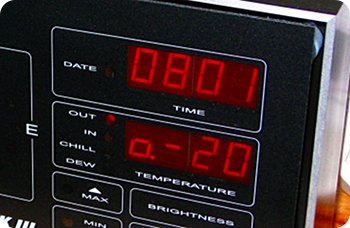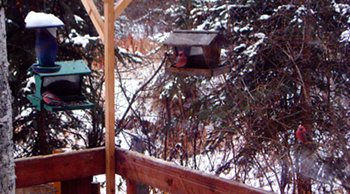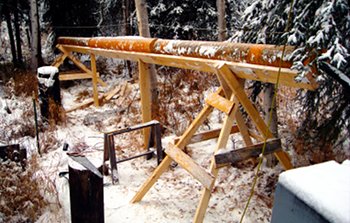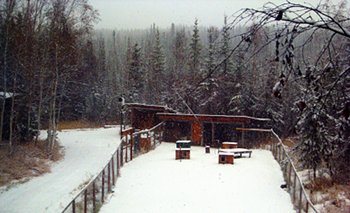
Barack Obama and his family
This week both The New Yorker and The New York Times released their editorial choice for president (here and here). It’s certainly no surprise that they picked Barack Obama. Both articles are devastating in their criticism of George W. Bush and the conservative politics he and John McCain endorse. It’s too bad the media didn’t do a better job documenting the excesses and evils over the last eight years; now it’ll be up to the historians to uncover exactly how we got where we are today.
At a moment of economic calamity, international perplexity, political failure, and battered morale, America needs both uplift and realism, both changes and steadiness. It needs a leader temperamentally, intellectually, and emotionally attuned to the complexities of our troubled globe. That leader’s name is Barack Obama.
The New Yorker Editors, 13 Oct 2008
I remember being very excited when Clinton was elected in 1991 after twelve years of Reagan / Bush, wondering to myself whether it would actually make any difference. I wasn’t initially convinced, but after eight years, we had peace and prosperity, and federal budget surpluses offered the possibility of universal health care, fixing our crumbling infrastructure, and shoring up Social Security and Medicare for the retirement of the Baby Boomers. And where are we today, eight years later? In ruin.
Let’s hope Barack Obama will be our next president and that he’s given a chance to bring our country back to where we were before it was hijacked by the fundamentalist, free-spending, for-the-rich, fascists of Bush / Cheney.
The United States is battered and drifting after eight years of President Bush’s failed leadership. He is saddling his successor with two wars, a scarred global image and a government systematically stripped of its ability to protect and help its citizens — whether they are fleeing a hurricane’s floodwaters, searching for affordable health care or struggling to hold on to their homes, jobs, savings and pensions in the midst of a financial crisis that was foretold and preventable.
As tough as the times are, the selection of a new president is easy. After nearly two years of a grueling and ugly campaign, Senator Barack Obama of Illinois has proved that he is the right choice to be the 44th president of the United States.
The New York Times Editorial Board, 23 Oct 2008
In the spirit of the spiteful nature of the McCain / Palin campaign, I offer this (undoctored) photo from the last debate:

My friends, it’s an easy choice.

-20°F
Today I brewed my 80th batch of beer, One-eyed Squirrel (named after a one-eyed squirrel that showed up at our feeders this fall). I decided to brew beer earlier in the week and last night I got the brewing water from Water Wagon (a coin-operated water depot where many people in Fairbanks go to get their drinking water). It’s more convenient to brew out by the red cabin than near the house, so I haul a 55 gallon drum of water out there. The water is normally around 40°F when it goes into the drum, and that’s a perfect temperature for the cold water supply used in my plate chiller which quickly chills boiling hot wort down to yeast pitching temperatures; around 68°F. When we went to bed last night it was a balmy 2°F outside, so I wasn’t worried about leaving the water out on the red cabin’s deck.
This morning, as you can see in the image on the left, it was -20°F, and the temperature of the water in the 55 gallon drum had dropped to 32°F. As soon as I started pumping it into the pot for the mash it froze in the lines to the pump. I wound up using a heat gun to keep the pipes and lines thawed while I pumped the water into a drum inside the red cabin where it’s warm. Six hours later when I was using the water to chill the wort, the water temperature was still 32°F. There’s a lot of energy between 32°F water that’s frozen and 32°F water that’s about to be 33 degrees, and I had 50 gallons of water somewhere between those two states all day today.
The brew went well. I double-ground the grains last night, and it paid off, giving me an 82% mash efficiency. Hopefully the yeast will take off later tonight or tomorrow and the beer will be good. It’s the first time I’ve used Cascade hops in several years and I’m hoping they don’t disappoint. In the past I’ve found the flavor to be somewhat soapy, but with the worldwide hop shortage, there’s limited selection when it comes to whole leaf hops. I’ll take what I can get.
This is my first batch using our old refrigerator as a fermentation chamber instead of the chamber I built several years ago. We keep the red cabin pretty cold in the winter, so the fridge is set up with an enclosed light bulb as a heater (just like the old fermentation chamber), but using a fridge allows for the possibility of cooling it down if the fermentation heats up the interior too much (a problem I’ve had in the past with the old fermentation chamber). I’ll also use it to brew lagers at some point. After 80 beers, maybe it’s time to give a lager a try.
We’ve been keeping track of all the animals we’ve seen in our yard, but now that it’s winter, seeing something new is rare. Last month we saw our first great horned owl of the fall season, and today the pine grosbeaks showed up. The males are a bright magenta color (like the three in the photo on the right) and the females are a light olive green color. Not only are they very colorful birds, they have a really delicate song that’s not at all what I expect to hear.
I took the picture through the sliding glass door to the deck, so there’s some glare on the window. Click on the photo for a larger version where you can really see them.
As you can tell from the photos I took today, fall is over and winter has started in Fairbanks. I didn’t get all my projects done, but this is one that’s been at the top of the list since I finished the shed. Because we’re so close to Goldstream Creek, we can’t have a septic field. Instead we have our own sewage treatment plant, built here in town by a company called Lifewater Engineering. It’s a great system, but we had some problems with our configuration last winter. Most notably, the discharge pipe partially froze.
The plant has three sections: a settling tank where the initial waste goes, a section with a substrate and air blower to foster bacteriological growth, and a final tank where cleaned water sits until it’s discharged. A float in the last chamber triggers a submersible pump to rapidly pump all the cleaned water up and out, through he discharge pipe, where it pours onto the ground. The discharge pipe is insulated, and because it’s got significant pitch and the discharge happens all at once, the pipe is supposed to stay clear all winter.
Unfortunately, the discharge pipe isn’t continuous; it’s three sections of ten foot pipe. When the pipe was hanging from a cable strung through the trees, it was very difficult to keep the pipes connected well enough that water didn’t build up at the junctions and freeze. Last winter we had to disconnect the last section of pipe, and most of the water wound up under our house.
To keep the pipe straight, and hopefully assist in keeping the water flowing downhill and out of the pipe, I built a 30 foot long trough by ripping a 45° bevel on the long edge of a series of rough cut 2x10’s. After offsetting the sides by five feet and nailing it together, I had a nice solid structure to support the pipe. I built the stands and intermediate supports today from 2x4’s and 1x6’s. This should make it much easier to work on the pipe if something goes wrong, and hopefully, it’ll keep the sections together and the water flowing.
There are a few more small projects left—like insulating the vent pipe as it passes through the attic, and working on the interior of the shed—but with the snow flying today, it’s time to sit back and hope that this summer’s work was enough to keep the house operational through the long Fairbanks winter.
A week or so ago we got a weather station (it’s the thing at the top of the pole on the left side of the dog yard fence in the photo) so we can keep track of the weather at our house. We’re one of the coldest places in the Fairbanks area, so we’re excited to see just how different our weather is. We’re sending the data to the Citizen Weather Observer Program where it’s ingested, analyzed, and disseminated by NOAA. I don’t know if they use it in their forecasting, but we’ve already shown up in a few Public Information Statements from the local forecast office.
Full details on the station, with some plots and other data reports (I’m still working on most of these…) are at http://swingleydev.com/weather/dw1454/. The station code is DW1454 and shows up in MADIS as D1454.


